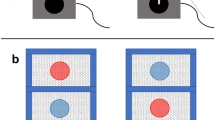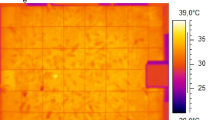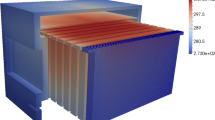Abstract
Eusocial insects are distinguished by their elaborate cooperative behavior and are sometimes defined as superorganisms. As a nest-bound superorganism, individuals work together to maintain favorable nest conditions. Residing in temperate environments, honey bees (Apis mellifera) work especially hard to maintain brood comb temperature between 32 and 36 °C. Heat shielding is a social homeostatic mechanism employed to combat local heat stress. Workers press the ventral side of their bodies against heated surfaces, absorb heat, and thus protect developing brood. While the absorption of heat has been characterized, the dissipation of absorbed heat has not. Our study characterized both how effectively worker bees absorb heat during heat shielding, and where worker bees dissipate absorbed heat. Hives were experimentally heated for 15 min during which internal temperatures and heat shielder counts were taken. Once the heat source was removed, hives were photographed with a thermal imaging camera for 15 min. Thermal images allowed for spatial tracking of heat flow as cooling occurred. Data indicate that honey bee workers collectively minimize heat gain during heating and accelerate heat loss during cooling. Thermal images show that heated areas temporarily increase in size in all directions and then rapidly decrease to safe levels (<37 °C). As such, heat shielding is reminiscent of bioheat removal via the cardiovascular system of mammals.






Similar content being viewed by others
References
Anderson C, McShea DW (2001) Intermediate-level parts in insect societies: adaptive structures that ants build away from the nest. Insectes soc 48:291–301
Bujok B, Kleinhenz M, Fuchs S, Tautz J (2002) Hot spots in the bee hive. Naturwissenschaften 89:299–301
Coelho J (1991) Heat transfer and body temperature in honey bee (Hymenoptera: Apidae) drones andworkers. Environ Entomol 20:1627–1635
Daumer K (1956) Metric study of color vision in bees. J Comp Physiol 38:413–478
Fahrenholz L, Lamprecht I, Schricker B (1989) Thermal investigations of a honey bee colony: thermoregulation of the hive during summer and winter and heat production of members of different bee castes. J Comp Physiol B 159:551–560
Fukuda H, Sakagami SF (1968) Worker brood survival in honeybees. Res Popul Ecol (Kyoto) 10:31–39
Gribakin FG (1969) Cellular basis of colour vision in the honey bee. Nature 223:639–641
Groh C, Tautz J, Rossler W (2004) Synaptic organization in the adult honey bees brain is influenced by brood-temperature control during pupal development. Proc Natl Acad Sci U S A 101:4268–4273
Hansell MH (1996) Wasps make nests: nests make conditions. In: Turillazzi S, West-Eberhard MJ (eds) Natural history and evolution of paper-wasps. Oxford University Press, Great Britain, pp 274–289
Heinrich B (1979) Keeping a cool head: honeybee thermoregulation. Science 205:1269–1271
Heinrich B (1980) Mechanisms of body-temperature regulation in honeybees. Apis mellifera: I. Regulation of head temperature. J Exp Biol B 85:61–72
Heinrich B (1985) The social physiology of temperature regulation in honeybees. Fortsch Zool 31:393–406
Hölldobler B, Wilson EO (2009) The superorganism. W.W. Norton and Company, New York
Jeanne RL, Morgan RC (1992) The influence of temperature on nest site choice and reproductive strategy in a temperatezone Polistes wasp. Ecol Entomol 17:135–141
Jones JC, Helliewell P, Beekman M, Malezka R, Oldroyd BP (2005) The effects of rearing temperature on developmental stability and learning and memory in the honey bee, Apis mellifera. J Comp Physiol A 191:1121–1129
Jones JC, Oldroyd BP (2006) Nest thermoregulation in social insects. Adv Insect Physiol 33:153–191
Kleinhenz M, Bujok B, Fuchs S, Tautz J (2003) Hot bees in empty broodnest cells: heating from within. J Exp Biol 206:4217–4231
Korb J (2003) Thermoregulation and ventilation of termite mounds. Naturwissenschaften 90:212–219
Kronenberg F, Heller HC (1982) Colonial thermoregulation in honey bees (Apis mellifera). J Comp Physiol A 148:65–76
Prange HD (1996) Evaporative cooling in insects. J Insect Physiol 42:493–499
R Core Team (2013) R: a language and environment for statistical computing. R Foundation for Statistical Computing. http://www.R-project.org
Sammataro D, Avitabile A (2011) Summer/fall management. In: The beekeeper’s handbook, 4th edn. Cornell University Press, New York, pp 109-124
Seeley TD, Morse RA (1976) The nest of the honey bee (Apis mellifera L.). Insect Soc 23:495–512
Seeley TD (1989) The honey bee colony as a superorganism. Amer Sci 77:546–553
Siegel AJ, Hui J, Johnson RN, Starks PT (2005) Honey bee workers as mobile insulating units. Insect Soc 52:242–246
Simpson J (1961) Nest climate regulation in honey bee colonies: honey bees control their domestic environment by methods based on their habit of clustering together. Science 133:1327–1333
Stabentheiner A, Pressl H, Papst T, Hrassnigg N, Crailsheim K (2003) Endothermic heat production in honeybee winter clusters. J Exp Biol 206:353–358
Starks PT, Gilley DC (1999) Heat shielding: a novel method of colonial thermoregulation in honeybees. Naturwissenschaften 86:438–440
Starks PT, Johnson RN, Siegel AJ, Decelle MM (2005) Heat shielding: a task for youngsters. Behav Ecol 16:128–132
Tautz J (2008) Cultivated intelligence. In: The buzz about bees: biology of a superorganism, 1st edn. Springer-Verlag, Berlin, pp 205-232
Tautz J, Maier S, Groh C, Rossler W, Brockmann A (2003) Behavioral performance in adult honey bees is influenced by the temperature experienced during their pupal development. Proc Natl Acad Sci U S A 100:7343–7347
von Frisch K (1967) Orientation when near the goal. In: Dance language and orientation of bees. Harvard University Press, Massachusetts, pp 465-523
Wheeler WM (1910) Ants: their structure, development and behavior. New York, New York
Wilson EO (1971) Social homeostasis and the superorganism. In: The insect societies. Harvard University Press, Massachusetts, pp 306-319
Winston ML (1987) The biology of the honey bee. Harvard University Press, Massachusetts
Acknowledgments
We thank Anne A. Madden, Kelsey Graham, Tyler Corey, and Georgiana Burruss for providing comments on previous drafts. This research was supported by the Tufts University Biology Department and the Tufts University National Science Foundation Research Experience for Undergraduates Program (DBI 263030).
Author information
Authors and Affiliations
Corresponding author
Additional information
Communicated by: Sven Thatje
Rachael E. Bonoan and Rhyan R. Goldman contributed equally to this work.
Rights and permissions
About this article
Cite this article
Bonoan, R.E., Goldman, R.R., Wong, P.Y. et al. Vasculature of the hive: heat dissipation in the honey bee (Apis mellifera) hive. Naturwissenschaften 101, 459–465 (2014). https://doi.org/10.1007/s00114-014-1174-2
Received:
Revised:
Accepted:
Published:
Issue Date:
DOI: https://doi.org/10.1007/s00114-014-1174-2




